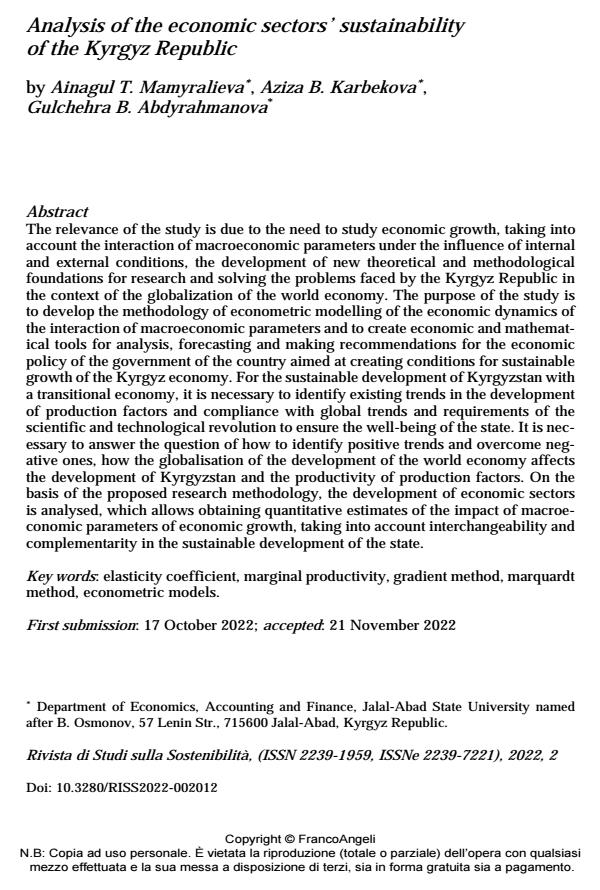Analysis of the economic sectors’ sustainability of the Kyrgyz Republic
Journal title RIVISTA DI STUDI SULLA SOSTENIBILITA'
Author/s Ainagul T. Mamyralieva, Aziza B. Karbekova, Gulchehra B. Abdyrahmanova
Publishing Year 2023 Issue 2022/2
Language English Pages 20 P. 185-204 File size 247 KB
DOI 10.3280/RISS2022-002012
DOI is like a bar code for intellectual property: to have more infomation
click here
Below, you can see the article first page
If you want to buy this article in PDF format, you can do it, following the instructions to buy download credits

FrancoAngeli is member of Publishers International Linking Association, Inc (PILA), a not-for-profit association which run the CrossRef service enabling links to and from online scholarly content.
The relevance of the study is due to the need to study economic growth, taking in-to account the interaction of macroeconomic parameters under the influence of internal and external conditions, the development of new theoretical and method-ological foundations for research and solving the problems faced by the Kyrgyz Republic in the context of the globalization of the world economy. The purpose of the study is to develop the methodology of econometric modelling of the econom-ic dynamics of the interaction of macroeconomic parameters and to create eco-nomic and mathematical tools for analysis, forecasting and making recommenda-tions for the economic policy of the government of the country aimed at creating conditions for sustainable growth of the Kyrgyz economy. For the sustainable de-velopment of Kyrgyzstan with a transitional economy, it is necessary to identify existing trends in the development of production factors and compliance with global trends and requirements of the scientific and technological revolution to en-sure the well-being of the state. It is necessary to answer the question of how to identify positive trends and overcome negative ones, how the globalisation of the development of the world economy affects the development of Kyrgyzstan and the productivity of production factors. On the basis of the proposed research methodology, the development of economic sectors is analysed, which allows ob-taining quantitative estimates of the impact of macroeconomic parameters of economic growth, taking into account interchangeability and complementarity in the sustainable development of the state.
Keywords: elasticity coefficient, marginal productivity, gradient method, mar-quardt method, econometric models.
- Development of International Entrepreneurship Based on Corporate Accounting and Reporting According to IFRS Elena G. Popkova, Shakhlo T. Ergasheva, pp.7 (ISBN:978-1-83797-666-9)
- Development of International Entrepreneurship Based on Corporate Accounting and Reporting According to IFRS Nilufar U. Babakhanova, Sonya M. Sultanova, Ayjan B. Djumanova, Maxim K. Kodirov, Saltanat T. Seytbekova, pp.221 (ISBN:978-1-83797-666-9)
- Development of International Entrepreneurship Based on Corporate Accounting and Reporting According to IFRS Yakutkhon K. Karrieva, Shakhlo A. Masharipova, Shahnoza S. Karrieva, Karimbergan S. Karriev, Nilufar B. Sobirova, pp.49 (ISBN:978-1-83797-666-9)
- Development of International Entrepreneurship Based on Corporate Accounting and Reporting According to IFRS Minovar M. Yuldasheva, Mamura N. Kushakova, Kunduz E. Igamberdiyeva, Nigora Ya. Ismailova, Saltanat T. Seytbekova, pp.229 (ISBN:978-1-83797-666-9)
Ainagul T. Mamyralieva, Aziza B. Karbekova, Gulchehra B. Abdyrahmanova, Analysis of the economic sectors’ sustainability of the Kyrgyz Republic in "RIVISTA DI STUDI SULLA SOSTENIBILITA'" 2/2022, pp 185-204, DOI: 10.3280/RISS2022-002012